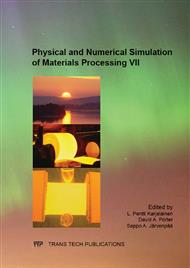p.140
p.146
p.152
p.158
p.165
p.171
p.176
p.183
p.189
Effect of Reheat Conditions on Microstructure Evolution and Precipitation Behavior in High Strength Linepipe Steel
Abstract:
The effects of slab reheat temperature and soaking time are studied to characterize austenite grain growth, microstructure homogeneity and dissolution of precipitates in linepipe X80 grade steel. It is shown that the uniformity of austenite microstructure strongly depends on the slab reheat temperature and soaking time. With increasing reheat temperature an abnormal growth of individual grains is observed that stems from gradual dissolution of microalloy carbonitrides. As the result, individual grain boundaries become unpinned and mobile thus "nucleating" secondary recrystallization. The highest reheat temperature at which the dissolution kinetics of precipitates is still slow enough to prevent the onset of secondary recrystallization within long soaking times is 1160°C. The as reheated austenite microstructure and the character of austenite grain size distribution are inherited throughout the entire roughing rolling sequence and even further downstream to the finishing rolling entry. The effects of reheat soaking time on shear fracture area and impact toughness are also described.
Info:
Periodical:
Pages:
165-170
Citation:
Online since:
July 2013
Keywords:
Price:
Сopyright:
© 2013 Trans Tech Publications Ltd. All Rights Reserved
Share:
Citation:


